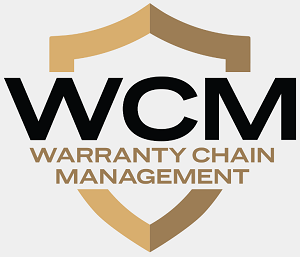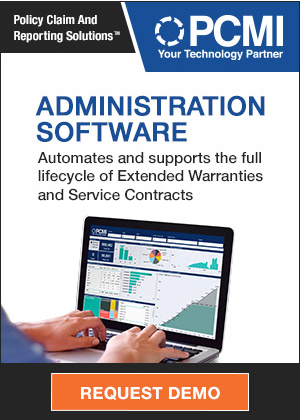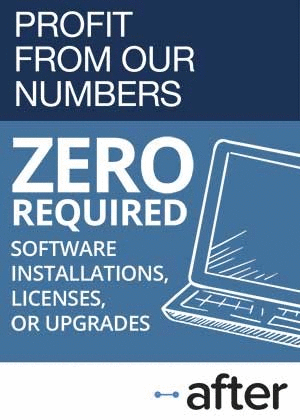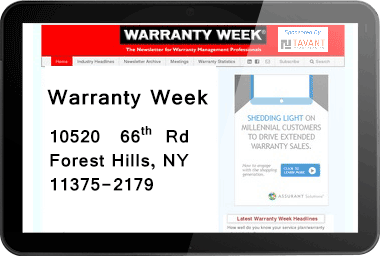January 31, 2013 |

|
ISSN 1550-9214 |
|
Editor's Note: This column by Chris Walker and Scott Cederburg of PwC is the latest in an ongoing series of contributed editorial columns. Readers interested in authoring a contributed column in the future can click here to see the Guidelines for Editorial Submissions page. Addressing Common Business Challenges Associated with Manufacturer Warranties:Proper estimation and accounting of warranty costs isn't easy, but the benefit of doing so is enormous. Actuaries in pursuit of precise and accurate forecasts can employ techniques similar to those used in estimating the financial impact of insurance coverage, and can help a company avoid restatements and other adverse impacts that could threaten its profitability.By Chris Walker and Scott Cederburg of PricewaterhouseCoopers LLP Manufacturers use warranties as a powerful marketing tool to help them build market share and customer good will. For example, when the quality of certain automobile brands came into question, automakers expanded warranty coverage both in terms of parts covered and duration. In fact, the industry not only expanded to a "bumper to bumper" concept, but also extended powertrain components. Some manufacturers recently increased their power train warranty from three years/36,000 miles to five years/100,000 miles, while the warranty on other components generally remained at three years/36,000 miles. Other manufacturers have increased powertrain warranties, though some have attached conditions, such as non-transferability (i.e. the manufacturer's warranty only applies as long as the original purchaser owns the vehicle). 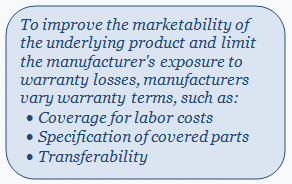
Despite warranties' obvious consumer appeal, they do add significantly to product pricing and pose accounting and cost estimation challenges. For example, in the automotive sector, warranty costs as a percentage of sales typically run between two and three percent. There are similar, though lower, percentages in other industries, such as white goods. Manufacturers typically express warranty costs in terms of cost per unit sold or cost per dollar of sales. The "cost per dollar of sales" measure is common for electronics and appliances. "Cost per unit" often is used in industries with a more uniform product, such as automobiles. In this article, we generally relate warranty costs to dollar of sales to facilitate comparisons among industry sources, which typically use this measure. To better understand their significance, warranty costs also may be expressed as a percentage of income. In low margin industries, warranty costs can easily surpass 25% of income. Proper estimation of these costs, particularly when terms change, is critical to avoid adverse impacts on a company's financials. Technical Accounting and Cost Recognition IssuesUnder U.S. Generally Accepted Accounting Principles, product warranties fall under accounting guidance set forth in the Financial Accounting Standards Board's Accounting Standards Codification: ASC 450 -- Contingencies (formerly known as FAS 5), and ASC 460 -- Guarantees (formerly known as FIN 45). This accounting guidance applies not only to explicit manufacturer's warranties, but also to goodwill claims and recall claims, although the interpretation and application of the accounting guidance to goodwill and recall claims varies by industry. Additional challenges apply when International Financial Reporting Standards (IFRS) serves as the relevant accounting framework. 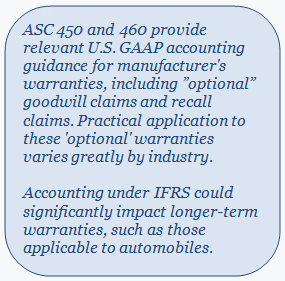
Because of the uncertainty surrounding the filing of warranty claims, warranty obligations fall within the definition of a contingency, and as such, a manufacturer should accrue losses from warranty obligations when losses are probable and reasonably estimable. This condition is met when, based upon available information, it is probable that customers will make claims under warranties related to goods or services that have been sold. For a new entity with no historical experience, consideration of the experience of similar entities may be appropriate. Goodwill claims, also referred to as "policy" claims, are the warranty-type claims that manufacturers pay not because of a contractual obligation but rather voluntarily at their discretion. They may do so in order to protect their reputation, to aid in marketing, or to subsidize servicers. Similar to explicit warranty losses, accounting guidance states that a company should accrue for goodwill claims when losses are probable and reasonably estimable. The approach manufacturers use to accrue for goodwill claims varies by industry. For example, automobile manufacturers typically establish an accrual for goodwill upon the sale of a vehicle; these expenses can be a material portion of total warranty costs. In other industries, manufacturers may not accrue for goodwill claims on the basis that the manufacturer has no obligation to perform and the actual goodwill claim costs are relatively low and/or infrequent. In such situations costs are expensed as incurred. Recall claims are subject to the same accounting considerations as warranty claims. Similar to goodwill claims, recognition of recall claims may vary from company to company. Also similar to goodwill claims, automotive manufacturers typically accrue for recall claims when a vehicle is sold. Companies in other industries typically accrue for recall claims at which time a company issues a recall or when it becomes probable that the company will issue a recall. IFRS considerations apply to warranty accounting as well. Under IFRS, fair value concepts, including discounting and a risk charge provision, apply to the recognition of liabilities. For short-term warranties such as those on electronics, discounting and risk charge would have only a nominal effect on the liability balances. For longer term warranties, such as those related to automobiles, the discounting provision and the inherent risk charges could be much more significant. Data Considerations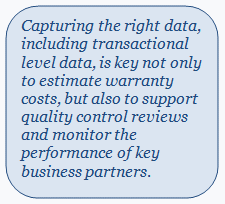
For larger warranty programs, such as those run by auto manufacturers, a company can have thousands of warranty transactions every day. Working with such large volumes of data requires systems to warehouse the data, as well as appropriate applications and software to extract the data, perform arithmetic operations, perform statistical analysis, and provide summaries by meaningful groupings, such as business unit, location or product type. Companies track an array of transactional information. This information not only helps companies refine liability estimates, it also can enhance quality control and performance monitoring of service providers and dealers/distributors, some of whose motivations may not align with the manufacturer's. For example, tracking claims frequency by part and service provider may help a company identify "high frequency" servicers and aid in future loss mitigation efforts. Information tracked includes both product (exposure) information and claim (loss) information:
An analysis of warranty liabilities must consider several data issues, including the following more significant items:
Estimation ProceduresThe approach to estimating warranty costs is similar to the approach for estimating losses associated with property/casualty insurance policies. The conditions also are similar. In both cases, the company prices a product in advance with an unknown, or at least uncertain, cost of inputs. Adequate estimation of warranty costs is critical for manufacturers to maintain profitability. Increases in warranty cost estimates over time -- "adverse development" -- often create a drain on earnings. In fact, several automobile manufacturers have recently had current year reductions in income -- some by over five percent -- due to revised estimates of "prior year" warranty losses. Because of the similarities between pricing warranties and insurance policies, both of which require pricing a product with unknown costs, actuarial models are the preferred method for establishing and updating warranty liability costs. Warranty cost estimation typically relies on the following basic methods, described from the simplest to more complex.
For longer term warranties, such as those that cover automobiles and other durable goods, the above methods generally are inadequate because they reflect only recent payment activity and ignore the fact that most warranty claims take place near the end a warranty period. Accordingly, the following methods are more applicable.
Sources of Volatility in Warranty Costs and Potential SolutionsWarranty costs are by no means static -- the introduction of new products, modification of existing products, regulatory changes, and coverage modifications all work to increase the variability and uncertainty of warranty costs. However, there are several ways to address such changes and work effectively in a dynamic environment.
ConclusionManufacturer's warranties play an important role in the business cycle. They can be critical to a product's sales and marketing, but also add significantly to product pricing, and pose accounting and cost estimation challenges. Maintaining transactional level detail is critical for manufacturers to provide meaningful management reports and data for pricing analysis and liability estimation, as well as enhancement of quality control and dealer/distributor performance monitoring. Actuaries can employ techniques similar to those used in estimating the financial impact of property/casualty insurance coverage, as product "failures" leading to manufacturer's warranty claims are contingent events similar to incidents commonly insured under insurance policies. Actuaries will consider the industry, type of warranty and other considerations to select methods to project costs and perform diagnostic analyses. Proper estimation and accounting of warranty costs, particularly with the introduction of new products or when warranty terms change, is critical to avoid restatements and other adverse impacts on financials that may be significant enough to threaten a company's profitability. About the Authors:
|
||||||||||||||||||||||||||||||||||||||||||||||||||||||||||||||||||||||||||||||||||||||||||||||||||||||||||||||
| ||||||||||||||||||||||||||||||||||||||||||||||||||||||||||||||||||||||||||||||||||||||||||||||||||||||||||||||






